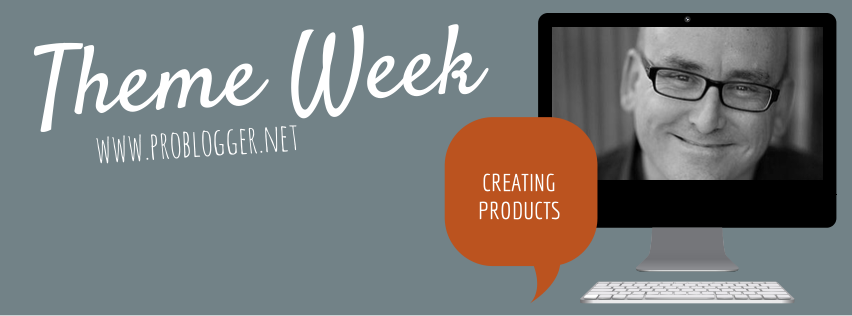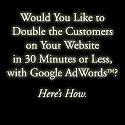

Creating Products Week: How to Create Products for Your Blog
 Darren says: Today is part 4 in our ‘creating products’ week here at ProBlogger and now that we’ve done a lot of the ground work and decided on what product to create, we’re moving onto the all-important challenge of actually creating the product that we want to sell on our blog.
Darren says: Today is part 4 in our ‘creating products’ week here at ProBlogger and now that we’ve done a lot of the ground work and decided on what product to create, we’re moving onto the all-important challenge of actually creating the product that we want to sell on our blog.
This is a huge topic and one that we can’t possibly go into great detail on, as it really does depend upon what kind of product you want to make – but below Shayne gives a great insight on how we do it at ProBlogger.
As usual – I’ll chime in with my perspective along the way.
 When I suggested this as a post topic to the ProBlogger team for product, I perhaps underestimated the true breadth of what I was saying. The reality is, to give you all the detail you’d need as a blogger to create a product of your own, it would be multiple books’ worth!
When I suggested this as a post topic to the ProBlogger team for product, I perhaps underestimated the true breadth of what I was saying. The reality is, to give you all the detail you’d need as a blogger to create a product of your own, it would be multiple books’ worth!
So what I’ll do today is give a bit of a behind-the-scenes look at the ProBlogger product-building machine – so you can then adjust what we do for your own specific circumstances.
I’m also going to assume that you’ve read both what to do before you create a product and what product should I create so we can focus purely on the construction side of things.
Think About ‘Selling’ First
When we agree on building a specific product (it might be an eBook, a service (like our SnapnDeals site), a private community (like ProBlogger.com, or even an event), the very first thing we do is: ‘sell it‘.
By ‘sell it’ I don’t mean to our readers, but sell it to ourselves.
This can either be in a team discussion or more formally in what I call a ‘sell sheet‘ – a document that contains all the vital information around the product (drawing on a lot of what you would have done in yesterday’s post).
The reason I like to sell first, build later is sometimes you can get so swept up in the romance of an idea that the practicalities and benefit to your readers get lost in the excitement.
 Darren says: Today when we create a product, we go through a more intentional process as a team of ‘selling’ the idea to ourselves as a team.
Darren says: Today when we create a product, we go through a more intentional process as a team of ‘selling’ the idea to ourselves as a team.
However, for my first eBooks I didn’t have a team and the ‘sell’ was largely an internal dialogue that I had in my mind.
I remember for my first photography eBook I had three topics that I was considering creating an eBook on. I was tossing up between eBooks on landscapes, portraits ,and something more general on techniques.
I took myself through some of the things that Shayne talked about in yesterday’s post to help me narrow down on the one I’d choose, but also as part of that process, began to think about ‘benefits’ of each eBook and how I’d sell them.
I listed each of these on paper and found by doing so I not only worked out which one I thought we’d sell more of – but by listing how I’d sell the eBook, I was then able to go and write something that would fit those benefits (i.e.: doing this improved the product).
I didn’t know it but in many ways I created the ‘sell sheet’ that Shayne talks about above.
Learn more about how to create a ‘sell sheet’ in this video. It’s a short excerpt of a webinar that Shayne and I ran for ProBlogger.com members last week on the topic of creating and selling eBooks. The full webinar goes into more detail but I thought this little section might help you work out what to put in your sell sheet.

Planning
Once we’ve created our ‘sell sheet’ we lock in a date for launch.
These dates are not just chosen to be when the product is ready – we also take into consideration other factors such as what else that’s happening on the site content wise, what else is happening in the wider business and other seasonal factors. We typcially allow for 4-6 months for creating an eBook and much longer for things like the ProBlogger community.
One of us, depending on the type product we’re developing, will then start to plan out how to create the product.
We don’t over-formalize this process, but rather focus more upon identifying:
- the key stages of product creation
- the resources well need
- the costs we’ll incur
We know that having a plan is important, but also that plans change so we don’t want to be too regimented.
If you’re building your first product, you might not actually know all the different stages. That’s when I’d be going and looking for advice. Find a mentor or mentor group that’s got experiences with these types of products. Pull a favour with someone you know that’s some a similar thing before. Get them to go through all the critical steps and be making lots of notes.
Doing this might create more questions than answers, but a least now you know the questions!
 Darren says: Our planning process today is more complex today than when I first started. For example when we create an eBook Jasmin (who manages all the production) will map out key dates and deadlines for all our different processes.
Darren says: Our planning process today is more complex today than when I first started. For example when we create an eBook Jasmin (who manages all the production) will map out key dates and deadlines for all our different processes.
So ahead of time we know when the eBook outline will be completed, when the writing needs to be complete, when the content will be handed over to our designer, when we need to have a title and cover concept finalised, when we need to start creating sales pages, when we need review copies for affiliates, etc.
Having these dates in place even before we start creating the product is really important. We have multiple eBooks at different stages of production at any one time (plus other projects and events on the go) so without timelines like this projects stall.
For my first eBooks, I didn’t have quite so formal a process but I still created a basic timeline and listed out the things I’d need to complete. I also listed the things I’d need to research (eg. shopping carts), the help I’d need to find (a designer) and the skills I’d need to learn that I didn’t yet have (e.g. writing a sales page).
My list was basic and written on a notepad next to my computer. I had to add a lot to it as I went but by at least having something in front of me each day I kept momentum going.

Outlining Your Product
Once you feel comfortable with the plan, it’s time to start outlining your product in more detail.
If it’s an eBook, it will be your table of contents, if it is an e-course outline, the structure and modules, if it’s a community or service, start to map out and wireframe all the different sections and moving parts of the site.
Think of it like drawing up the plans to a house you’re about to build yourself, or hire someone to build it for you.
Now it’s time to build. This is either going to be yourself or you’ll give the green light to someone else.
If it’s yourself, you need to allocate some time. It might be a specific day you allocate, or one hour a morning, or you might be lucky and be able to just bunker down for a few weeks at a time to write.
Figure out an approach that you’re most likely to stick to, and make sure you block out that time in your diary. Once you have done that, it’s up to you to stick to it.
Whilst in creation mode, you should continually check in with your ‘sell sheet’, to make sure you’re still driving towards solving the same problem you set out to, but don’t let it slow your progress. We’ll have time to review later — just keep building and building.
When you get about halfway through the writing or building stages, if you’re anything like me you’ll get a case of the mid-build blues.
You’ll probably start to feel fatigued, disillusioned, distracted, and will wonder if anyone is going to buy what you’re creating.
This is the stage that a lot of great products die – and that’s a real shame.
When you feel those emotions creeping in, I want you to dig deep, find any motivation or inspiration you can, and keep going! Just push to that 60,70, 80% completion mark and you’ll feel closer to the end.
When it’s done you’ll be thankful you did!
 From Darren: I won’t lie to you here… some of my least favourite moments in the last 12 years have happened midway through creating products.
From Darren: I won’t lie to you here… some of my least favourite moments in the last 12 years have happened midway through creating products.
The reality is that it is hard work to build something like this, and that to get it done, you need to find a way to focus and be disciplined (something that this blogger with a very short attention span and little will power struggles with).
For me it meant asking those around me to keep me accountable, setting aside time to focus (I’ve been known to lock myself in motel rooms for weekends) and setting myself little rewards for meeting milestones.
The other challenge that I often face mid-product creation is that of fear and doubt. How will people perceive what I’m creating? Will anyone buy it? Is it any good? Am I wasting my time?
I’ve written here about some of how I deal with these fears and doubts.
Lastly, try to keep the WHY of what you’re doing in focus (see yesterday’s post for more on why WHY is so important).

Polish Your Product
Just when you think you are finished… that’s when I can give you the bad news… you’re not!
It’s time to polish.
This is the final 5% that can really make your product stand up.
At this point you need to switch your mind from make mode to review mode, and I’m sure you’ll come up with a few small changes that will make things better.
Involve some of your friends, family or even some of your readers in this review process and you’ll significantly improve your product.
Listen to the feedback you get from and act on what you hear, but be aware that there is a trap.
The key is to remember that you’re ‘polishing’ not ‘perfecting’. There’s no such thing as a perfect product – you need to let that idea go.
There will be always things that you want to change and add to theoretically make things better. It will be never-ending and I can tell you with 100% certainty, you’ll never make a single dollar if you don’t finish your product, so loose ends or not — ALWAYS BE SHIPPING!
 Darren says: I think most people fall into one of two categories when they’re at this point.
Darren says: I think most people fall into one of two categories when they’re at this point.
The first group ‘finish’ creating and never want to look at their product again. The result is they do little reviewing/polishing and ship products that could be better.
The second group spend so much time polishing and perfecting that they either don’t ship anything because the product is never ready or they end up with a product that is over engineered.
Identifying ahead of time which group you’re in and coming up with strategies to combat your weakness is important.
If you’re in the first group (like me) involving others in the review and polish can be helpful. Also blocking out time for this important task is important before you rush off to your next idea.
If you’re in the second group setting a deadline for shipping can be important too. There has to be a point where you stop!
My last advice for this stage is to echo what Shayne says about involving others. If you’ve authored your product yourself you are probably too close to it to be objective and will miss obvious errors and deficiencies – so whether it is by paying others for editing/proof reading or by giving a small group of readers free access in return for feedback – get others’ feedback before you launch your product.

Outsourcing
A special note for those using suppliers to create your product: for a lot of you, the biggest resource you’ll use will be yourself. However, technical services you might create, or online courses and communities, might involve a wider team.
Your choices on who works on your project can have a huge bearing on the end result. Don’t just pick someone at random, or the cheapest resource you can find.
Make sure they understand exactly what you are trying to achieve, make sure they have the skills and experience to deliver what you want, and make sure they have the commitment to see it to the end.
At the end of the day it’s your name attached to the product not theirs, so choosing the right person is so important.
Be Proud
Above all – be proud of what you create.
Even if the product isn’t as commercially successfully as you hoped it to be know that by creating it you’ve achieved something only a small number of people will in their lives.
For that, you get a hat tip from me!
Originally at: Blog Tips at ProBlogger
Creating Products Week: How to Create Products for Your Blog
Facebook comments:
No Comments »
No comments yet.
RSS feed for comments on this post. TrackBack URL
Leave a comment
















